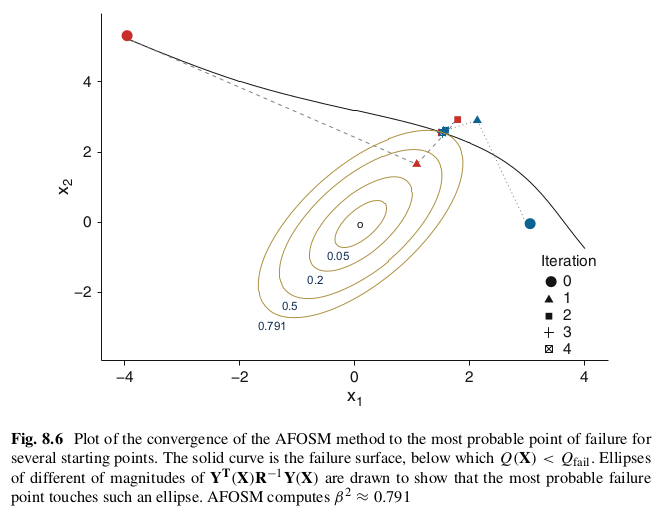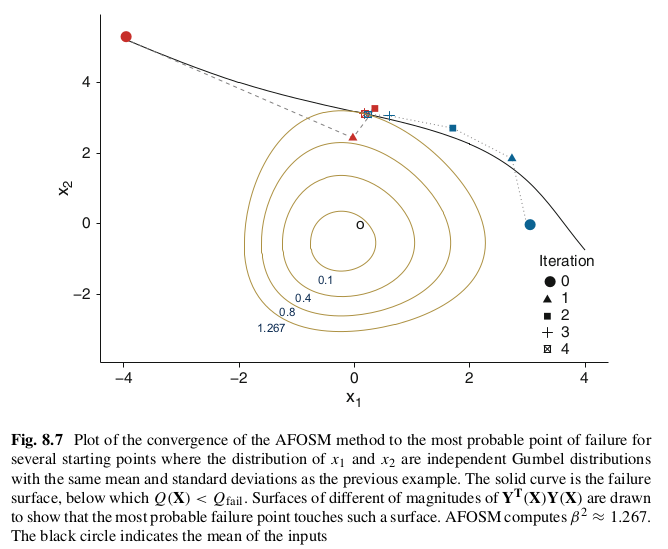This notebook contains material from cbe67701-uncertainty-quantification; content is available on Github.
8.3 Advanced First-Order Second-Moment Methods¶
Created by Michael J. Quevillon (mquevill@nd.edu) 2020-07-07
The following text, example, and code were adapted from:
McClarren, Ryan G (2018). Uncertainty Quantification and Predictive Computational Science: A Foundation for Physical Scientists and Engineers, Chapter 8: Reliability Methods for Estimating the Probability of Failure, Springer, https://doi.org/10.1007/978-3-319-99525-0_8
# Import libraries
import matplotlib.pyplot as plt
%matplotlib inline
import numpy as np
from scipy.stats import gumbel_r, norm
# Download figures
import os, requests, urllib
# GitHub pages url
url = "https://ndcbe.github.io/cbe67701-uncertainty-quantification/"
# relative file paths to download
# this is the only line of code you need to change
file_paths = ['figures/Fig-8.6.png', 'figures/Fig-8.7.png']
# loop over all files to download
for file_path in file_paths:
print("Checking for",file_path)
# split each file_path into a folder and filename
stem, filename = os.path.split(file_path)
# check if the folder name is not empty
if stem:
# check if the folder exists
if not os.path.exists(stem):
print("\tCreating folder",stem)
# if the folder does not exist, create it
os.mkdir(stem)
# if the file does not exist, create it by downloading from GitHub pages
if not os.path.isfile(file_path):
file_url = urllib.parse.urljoin(url,
urllib.request.pathname2url(file_path))
print("\tDownloading",file_url)
with open(file_path, 'wb') as f:
f.write(requests.get(file_url).content)
else:
print("\tFile found!")
8.3.1 Gumbel Distribution¶
N = 5000
gumbel = gumbel_r.rvs(size=N)
plt.hist(gumbel, bins=50, density=True)
plt.xlabel("x")
plt.ylabel("Gumbel distribution")
plt.show()
8.3.2 Advanced FOSM¶
FOSM is independent of the underlying distributions. As we have learned, two distributions can have the same mean and variance and still be wildly different in their overall distributions. Advanced FOSMs try to incorporate the true underlying distributions.
8.3.2.1 Example QoI¶
$Q(\mathbf{x}) = 2 x_1^3 + 10 x_1 x_2 + x_1 + 3 x_2^2 + x_1$
def checksize2(x):
if np.array(x).size != 2:
raise InputError("Input to Q(x) must be of size 2.")
def Q(x):
checksize2(x)
return 2*x[0]**3 + 10*x[0]*x[1] + x[0] + 3*x[1]**3 + x[1]
def delxQ(x):
checksize2(x)
return np.array([
6*x[0]**2 + 10*x[1] + 1,
10*x[0] + 9*x[1]**2 + 1
])
def y(x, mean, var):
checksize2(x)
checksize2(mean)
checksize2(var)
return np.divide(x - mean, var)
def x(y, mean, var):
checksize2(y)
checksize2(mean)
checksize2(var)
return np.multiply(y, var) + mean
# y = (x-mean)/var
# dx/dy = var
# dely is just var*delx
def delyQ(x, var):
checksize2(var)
return np.multiply(delxQ(x), var)
8.3.2.2 Example for Figure 8.6¶
This example shows AFOSM with two variables that have a multivariate normal distribution. The off-diagonal terms in the covariance and correlation matrices indicate that these variables are not independent!
# values from the book
mean = np.array([0.1, -0.05])
sigma = np.array([[4, 3.9],[3.9, 9]])
var = np.sqrt(np.diagonal(sigma))
R = np.array([[1, 0.65],[0.65, 1]])
Qfail = 100
tol = 1e-6
delta = tol
eps = tol
def AFOSM_gaussian(x0, iters=25):
xcurr = np.array(x0)
betacurr = 1000 # arbitrarily large value
betas = np.empty(N+1)
betas[:] = np.nan
betas[0] = betacurr
X = np.empty((2, N+1))
X[:] = np.nan
X[:, 0] = xcurr
isConverged = False
for l in range(N):
ycurr = y(xcurr, mean, var)
dyQ = delyQ(xcurr, var)
lamb = (Qfail - Q(xcurr) + dyQ @ ycurr)/(dyQ @ R @ np.transpose(dyQ))
ynext = lamb * R @ np.transpose(dyQ)
betanext = np.sqrt(np.transpose(ynext) @ np.linalg.inv(R) @ ynext)
xnext = x(ynext, mean, var)
if np.abs(betanext - betacurr) < delta and np.abs(Q(xnext) - Qfail) < eps:
isConverged = True
break
betacurr = betanext
xcurr = xnext
X[:, l+1] = xnext
betas[l+1] = betanext
if not isConverged:
print(f"AFOSM did not converge in {N} iterations!")
X = X[:,~np.isnan(X).any(axis=0)]
betas = betas[~np.isnan(betas)]
return X, betas
Using all of these functions we have defined, we can then just put an initial guess into this to recreate the figures from the book.
plt.figure(figsize=(8,5))
xred, _ = AFOSM_gaussian([-4, 5])
plt.plot( xred[0,:], xred[1,:], marker="o", color="r")
xblue, _ = AFOSM_gaussian([3, 0])
plt.plot(xblue[0,:], xblue[1,:], marker="o", color="b")
plt.xlim([-4.5,4.5]); plt.ylim([-4,6])
plt.show()
The following is Figure 8.6 from McClarren (2018):

This is a relatively simple story, but there's more to this story...
plt.figure(figsize=(8,5))
xred, _ = AFOSM_gaussian([-4, 5])
plt.plot( xred[0,:], xred[1,:], marker="o", color="r")
xblue, _ = AFOSM_gaussian([3, 0])
plt.plot(xblue[0,:], xblue[1,:], marker="o", color="b")
xgreen, _ = AFOSM_gaussian([-1,-1])
plt.plot(xgreen[0,:], xgreen[1,:], marker="o", color="g")
xpurple, _ = AFOSM_gaussian([-4,-1])
plt.plot(xpurple[0,:], xpurple[1,:], marker="o", color="m")
plt.show()
import itertools
lx = np.linspace(-4, 4, 9)
ly = np.linspace(-4, 6, 11)
# lx = [-4]
# ly = [1]
plt.figure(figsize=(16,9))
for pt in itertools.product(lx, ly):
X, b = AFOSM_gaussian(pt)
# plt.plot(X[0,-1], X[1,-1], marker="o")
plt.plot(X[0,:], X[1,:])
plt.xlim([-4.5,4.5]); plt.ylim([-4,6])
plt.show()
Using basic FOSM, we get that the probability of failure is functionally zero, because the estimate of beta from Eq. (8.5) (basic FOSM) is 14.6.
Since the point of interest has $Q << Q_{fail}$, AFOSM is necessary to determine the point of failure.
8.3.2.3 Example for Figure 8.7¶
This example shows AFOSM with two independent variables that each have a Gumbel distribution.
NOT CURRENTLY WORKING
# All other input parameters are kept the same
R = np.array([[1, 0],[0, 1]]) # completely independent!
def gumbel_std(x, mean):
var = np.empty(2)
for i,_ in enumerate(x):
var[i] = norm.pdf(norm.ppf(gumbel_r.cdf(x[i], loc=mean[i]), loc=mean[i]), loc=mean[i])/gumbel_r.pdf(x[i], loc=mean[i])
return var
def AFOSM_gumbel(x0, iters=100):
xcurr = np.array(x0)
betacurr = 1000 # arbitrarily large value
betas = np.empty(N+1)
betas[:] = np.nan
betas[0] = betacurr
X = np.empty((2, N+1))
X[:] = np.nan
X[:, 0] = xcurr
isConverged = False
for l in range(N):
mean_g = gumbel_r.median(loc=mean)
var_g = gumbel_std(xcurr, mean_g)
ycurr = y(xcurr, mean_g, var_g)
dyQ = delyQ(xcurr, var_g)
lamb = (Qfail - Q(xcurr) + dyQ @ ycurr)/(dyQ @ R @ np.transpose(dyQ))
ynext = lamb * R @ np.transpose(dyQ)
betanext = np.sqrt(np.transpose(ynext) @ np.linalg.inv(R) @ ynext)
xnext = x(ynext, mean_g, var_g)
if np.abs(betanext - betacurr) < delta and np.abs(Q(xnext) - Qfail) < eps:
isConverged = True
break
betacurr = betanext
xcurr = xnext
X[:, l+1] = xnext
betas[l+1] = betanext
if not isConverged:
print(f"AFOSM did not converge in {N} iterations!")
X = X[:,~np.isnan(X).any(axis=0)]
betas = betas[~np.isnan(betas)]
return X, betas
plt.figure(figsize=(8,5))
xred, betas = AFOSM_gumbel([-4, 5])
print(betas)
plt.plot( xred[0,:], xred[1,:], marker="o", color="r")
xblue, _ = AFOSM_gumbel([3, 0])
plt.plot(xblue[0,:], xblue[1,:], marker="o", color="b")
plt.xlim([-4.5,4.5]); plt.ylim([-4,6])
plt.show()
The following is Figure 8.7 from McClarren (2018):

